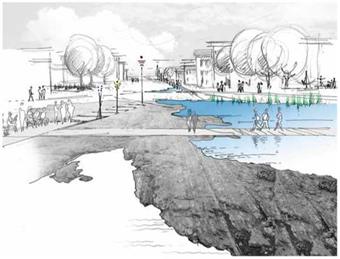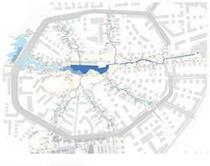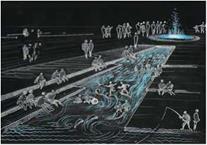|
Generally, when one thinks of Norway, an image of endless natural beauty and intrinsic healthiness comes to mind. And this is mostly the case in a country of natural water landscapes. However, when taking a closer look at cultural and urban centers such as Oslo, even in this land of natural bounties, the worldwide conflict between nature and modern civilization is present. Once a pristine island in the Oslo Fjord, in the 1950s Fornebu became Oslo’s main airport and transit point for flights throughout Norway. The typical glacial topography was shaved down with bulldozers and machinery to provide the wide flat open spaces needed for runways. Fragments of the original landscape persisted, scattered disconnectedly in unusable niches. In the 1990s it became apparent that, although close to the city centre, the airport no longer had the capacity to handle the increasing air traffic demand. Because of the spatial limits of the island, it was decided to build a new airport 100 kilometres north of Oslo, today’s Gardemon Airport. The surrounding city districts of Fornebu immediately saw the potential for an attractive housing and business development close to the city centre. This new suburb will also feature a central park for recreation, simultaneously the site for sustainable water management. Fortunately, there was an overall consensus that the development should be carried out in a sustainable and ecologically aware manner, giving the fragmented but authentic scatterings of original landscape special consideration. Subsequently, more than ten years were spent carrying out soil remediation measures to deal with the heavy pollution residues left by airport traffic. In light of these pollution concerns, water and site water management were consistently crucial themes throughout several stages of open design |
|
competition. In 2004, Atelier Dreiseitl was selected to compliment Bjerbekk & Lindheim’s spatial concept with a comprehensive water design. Every drop of rain water which falls on the roughly 200 hectare site is collected, cleansed and re-used, infiltrated, or slowly released to the fjord. An artificial lake becomes the focus of the central park within the development. A water axis connects the former control tower to the lake, conveying stormwater from the surrounding roofs, streets, sidewalks and surfaces and evoking the gestures of travelers – their longing for a change of scene, for arrivals and departures – in artistic water interventions along the water axis. Nestled into the lake, a promenade, cafe and light-ice installations for the long arctic evenings are highlights connected by less formal seating and shoreline. The lake itself is a stormwater basin accommodating precipitation dependant on fluctuating water levels. Overflow water feeds the ‘froglands’, a species diverse wetland area, before slowly seeping into the Oslo fjord. |
|
The collected rainwater is circulated through cleansing biotopes which through simple, green and transparent technology ensure excellent water quality. During major storm events, excess water can overflow to a wetland area where, after several cleansing phases, it flows into the sea. |
|
The plaza at the lake is a playful and central meeting point for the new town. |
|
Thanks to a network of park systems, rainwater is conveyed in open green swales from the different housing estates to the central lake. |
|
The central park is above all a place for relaxation and enjoyment for residents. The park design is not inhibited by the fact that it also serves as an effective component of the comprehensive rainwater management system. |
|
Collection stormwater |
|
Circulation lake and watercourse |
|
Overflow and release |
|
69 |
![]()

![]()


![]()
|




